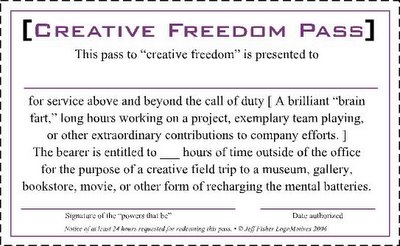In appreciation for putting in long hours, to note the finalizing a major project effort, or to celebrate the department receiving some outside recognition, she would put what she referred to as a "creative hall pass" into action. Staff would be given extra time off, sent out of the office to "recharge" their creativity, or told to head down to a local pub for a "coffee break."
Over the years I have expanded on the idea of, what I now call, the "Creative Freedom Pass." I have also come up with 10 tips for those responsible for the proper care and feeding of the in-house graphic designer. The following was first presented at a CreativeBloc conference sponsored by the Marketing, Advertising & Communication Professionals of Northeast Iowa.
A Designer User's Manual
Ten simple tips, presented as a primer to clients, employers and those supervising design staffs, to encourage improved performance from their graphic designers.
1. Avoid Smothering
Your designer does most often realize who is the boss. Don’t over-manage, or smother, your “creative type.” Allow your designer the time to create without constant progress checks and over-the-shoulder design input.
2. Supply Needed Tools
An ill-equipped designer is not necessarily going to lead to stellar results. Provide your designer with up-to-date equipment and tools. Trust your designer to provide the expert input on what is required to do the best job for you.
3. Nurture and Educate
The design industry is changing dramatically daily. Your designer needs to be “upgraded” on a regular basis. Workshop or conference attendance, continuing education courses and magazines subscriptions help a designer stay healthy.
4. Encourage Interaction
The natural habitat of the designer is not the office in the back - isolated from all others in the company. Present opportunities for interaction and brainstorming with the rest of the staff, including those initially concepting projects and the end users of a given piece.
5. Allow Creative Freedom
Let your designer out of their box, or cubicle, on a regular basis, Creativity can’t be turned on like a computer or light switch. Designers need outside stimuli for a productive life span. (The “Creative Freedom Pass” below is a great idea.)
6. Coach Your Designer
Designers do not respond well to “training” preparing them to “sit,” “heel” and “roll over.” Invest the time to coach, (rather than train) your designer in a positive manner about the culture, history and philosophies of your business.
7. Provide ALL Information
Being “selfish” with project specifications, client feedback, budgetary restrictions and other information will not be of benefit to you or your designer. Sharing all information openly will allow your designer to do their best job.
8. Define REAL Deadlines
“When you get around to it” or “ASAP” are not realistic definitions of project deadlines. Establish actual timelines with your designer for the delivery of concepts, presentation of revisions and the completion of needed designs.
9. Critique Constructively
Telling a designer their project “sucks” or you “just don’t like it” is not feedback that will lead to a successful end result. Explain your reasoning in detail and offer possible solutions. Offer praise or encouragement when earned.
10. Recognize and Reward
A happy designer is a productive designer - and a very valuable asset to your company. A simple ‘thank you” for a job well done, sponsorship of a design competition entry, blatant praise in front of other staff, and other signs of acknowledgment are great investments. (Again, a “Creative Freedom Pass” is a nice reward.)
This article originally appeared on Commpiled.com and bLog-oMotives.
© 2007 Jeff Fisher LogoMotives








